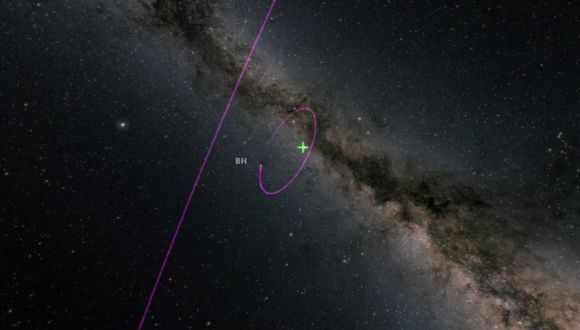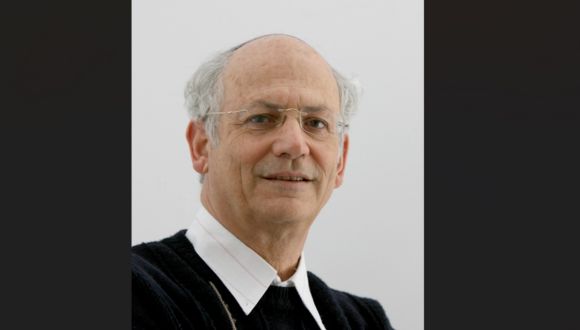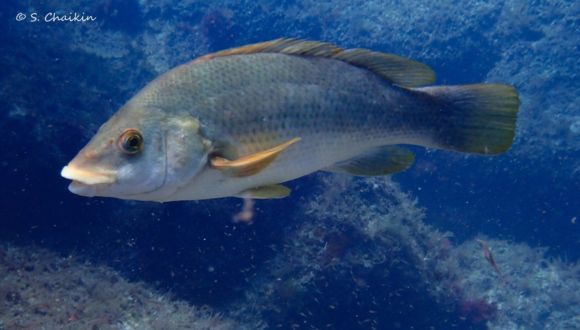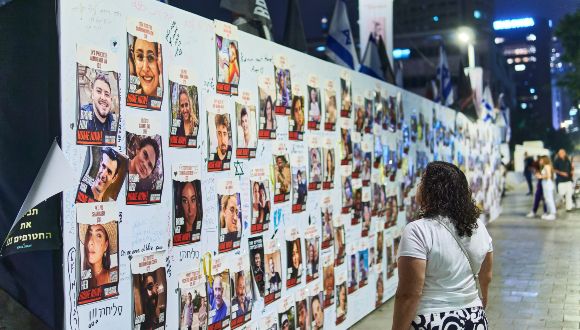Gaia Spacecraft Reveals Massive Black Hole in Milky Way


Research
Gaia Spacecraft Reveals Massive Black Hole in Milky Way

An international team of researchers, with the participation of researchers from Tel Aviv University (TAU) led by Prof. Tsevi Mazeh, discovered a star which orbits a black hole 33 times heavier than the sun’s mass, and lies 1500 light-years away from Earth. The black hole, discovered using data from the European Gaia spacecraft, is more than three times heavier than the other known black holes in our galaxy.
The Gaia spacecraft was launched by the European Space Agency in 2013 and has since then been regularly measuring the position and brightness of over a billion stars in our galaxy – the Milky Way galaxy – with unprecedented precision, equivalent to accurately determining the position of a single grain of sand on the moon to the millimeter.
An organization of hundreds of scientists across Europe processes the data coming in from the spacecraft and makes it accessible to the entire scientific community. The research group was led by Prof. (emeritus) Tsevi Mazeh, from TAU’s Raymond and Beverly Sackler School of Physics and Astronomy, recently awarded the Israel Prize in Physics for the year 2024. Prof. Mazeh participates in the study of binary star systems discovered using spacecraft data. The research was published in the prestigious journal Astronomy & Astrophysics.

Credit: ESA/Gaia/DPAC
Cosmic Odyssey: Exploring the Depths of the Universe
The large sample of binary stars should also include systems which include a black hole - one of the rarest celestial objects in the universe. The existence of a black hole is one of the most amazing phenomena in the universe, the existence of which was predicted by Einstein’s theory of general relativity back in 1939.
According to the accepted theory, when the fuel for the nuclear combustion process that takes place in the core of a star runs out, it collapses in on itself, towards its center. If the star is massive enough, all the remaining matter collapses into a single point of infinite density. It is possible, therefore, to see the black hole as the “corpse” of a star that has ended its life cycle and collapsed in on itself. Astrophysicists are still trying to understand the extreme conditions that lead to the collapse of matter into the central point, and therefore every discovery of a black hole is accompanied by enormous excitement among astronomers.
Into the Abyss of the Black Hole
It is very difficult to discover black holes since light cannot overcome the strong gravitational force in its vicinity. When a black hole is in a binary system with a normal star, the motion of the visible star is used to measure the mass of its invisible partner and thus prove that it is indeed a black hole. Indeed, in a matter of just a few years, the Gaia spacecraft has already discovered two black holes.
With the expectation that the data that continues to be collected by the spacecraft will lead to the discovery of more black holes, Prof. Mazeh together with Prof. Laurent Eyer from the University of Geneva established a small team to find black holes using the spacecraft’s data, including scientists from France, Germany, Spain, Belgium, Poland and Switzerland. While examining the new data, the team came across a binary system containing a special black hole, the likes of which has never been found before, with a mass of 33 solar masses, around 1,500 light years away from us.
The new black hole is more than three times heavier than any other known black hole in the Milky Way galaxy. The binary system, named Gaia BH3, contains an ordinary star that seems to have formed more than ten billion years ago when our galaxy was still very young. The star orbits the black hole in an 11-year cycle.

Prof. Tsevi Mazeh - 2024 Israel Prize Winner in Physics
At the suggestion of Prof. Mazeh, it was decided to publish the sensational disclosure right now and not wait until the orderly publication of all the systems that were discovered. The entire spacecraft team, including researchers from TAU - Prof. Shay Zucker, head of the Porter School of Environment and Earth Sciences, Dr. Simchon Faigler, Dr. Sahar Shahaf (now at the Weizmann Institute), Dr. Dolev Bashi (now at the University of Cambridge), Avraham Binnenfeld (research student) and Oded Orenstein (second-year undergraduate student) - are listed as contributors to the scientific article published today which reports on the discovery.
Prof. Tsevi Mazeh: “This is an exciting discovery of the heaviest black hole in a binary system known today in the galaxy. About thirty years passed from the first hypothesis of the existence of a black hole until the discovery of the first black hole, and more than fifty years passed before we were able to discover Gaia BH3 - the binary system with the longest cycle known today. It is amazing how humankind manages to navigate the vast expanses of the universe and discover such mysterious objects. I am convinced that the discovery will lead to a new mode of thinking regarding the presence and prevalence of the black holes that cruise through the expanses of our galaxy.”

Research
A Recent TAU Study Exposes the Connection Between Heart Disease and Cancer

Researchers at Tel Aviv University and the Leviev Cardiothoracic and Vascular Center at the Sheba Medical Center have found a mechanism that is responsible for increasing the risk of developing cancer among patients with heart disease: those small extracellular bubbles, or vesicles (sEVs), that are secreted from the sick heart to heal itself are released into the bloodstream – and promote the growth of cancer cells throughout the body. The researchers estimate that the important discovery may improve the protocols for treating heart disease so that clinicians also consider the increased risk of cancer. The study was funded by the Israel Cancer Association and the Israel Science Foundation.
The research was conducted under the leadership of Prof. Jonathan Leor from the Neufeld Cardiac Research Institute, Faculty of Medical & Health Sciences at Tel Aviv University and the Taman Institute at Sheba’s Leviev Center and his student Tal Caller, a medical and research student at Tel Aviv University's School of Medicine. The research was published in the important medical journal Circulation.
Caller explains: “In 2013, the Israeli cardiologist Tal Hasin showed for the first time that there is a connection between heart failure and cancer. Patients with heart disease are at a higher risk of developing cancer, and since heart disease is already a leading cause of death–first place in the US and second place in Israel – that means that many people are at risk. Our research revealed that the diseased heart secretes cancer-promoting factors, which we identified as small extracellular vesicles (sEVs). These are tiny particles wrapped in a simple membrane, which all cells secrete, However, due to heart damage, these vesicles are released in greater quantities and contain factors related to inflammation, healing, growth, creation of new blood vessels, and changes in the immune system. These vesicles move through the circulatory system and eventually reach the tumor or the pre-cancerous tissue”.
Caller adds, “Following an injury in the heart muscle and deterioration to heart failure, sEVs containing growth factors and small nucleic acid molecules that promote cell division are released. These sEVs contribute to the healing of the injured cardiac tissue. However, released from the injured heart, those vesicles move within the body’s circulatory system, eventually targeting cancerous growths”.
Prof. Jonathan Leor: “Many theories have been proposed to explain the increased risk of cancer in heart patients. They started with shared risk factors such as smoking, diabetes, and obesity and ended with a single protein or molecule. We showed for the first time that the diseased heart secretes sEVs that contain thousands of different growth factors. These bubbles directly promote the growth of certain tumors and also modulate the immune system, making the body more vulnerable to tumor growth”.
To test their hypothesis, the researchers at TAU inhibited the formation of sEVs in animal models with heart disease and found that the risk of cancer decreases along with the inhibition of vesicle production. However, this is not a viable therapeutic option since inhibiting the production of the vesicles causes severe undesired side effects.
Prof. Leor: “When you systemically inhibit the formation of sEVs, you get less cancer – but you cause collateral damage along the way. That is why we tried a different strategy: treat the patient’s heart to reduce the damage to the cardiac tissue so that it secretes fewer sEVs. We used spironolactone, which is a well-known, old, and effective drug used to treat heart failure. We treated the animals with spironolactone at a very early stage of the disease and found that the heart secreted 30% fewer sEVs– and the cancerous tumors grew more slowly. Our experiment shows that it is possible to intervene in heart disease in a way that reduces the risk of cancer among heart patients”.
As for the clinical implications of the study, Caller is careful in his words: “It may be necessary to adjust the existing treatments for the heart so that they also consider the risk of cancer. In addition, it is possible to find biomarkers among heart patients that will indicate an increased risk of cancer since not all patients are at an increased risk. This is basic research, and much work is still required to unravel the connection between the two”.
Moshe Bar-Haim, CEO of the Israel Cancer Association, adds: “Thanks to public donations and designated funds, the research committee of the Israel Cancer Association examines and selects dozens of studies every year and funds researchers and doctors from research and treatment centers across Israel. From these studies, new methods were developed for the diagnosis, treatment, and rehabilitation of cancer patients. Research has no territorial boundaries, so every achievement in research here in Israel is an achievement for the entire world. We hope that the new research – that reveals that because of heart diseases, extracellular bubbles are secreted and increase the risk of cancer – will allow for immediate application in Israel and around the world for the benefit of accurate treatment for patients”.

Research
How Does Global Warming Impact Fish Abundance?

An extensive international study led by researchers from Tel Aviv University found a decline in the abundance of marine fish species that rapidly move toward the poles to escape rising sea temperatures. The researchers explain that many animal species are currently moving toward cooler regions as a result of global warming, but the velocity of such range shifts varies immensely for different species. Examining thousands of populations from almost 150 fish species, the researchers show that contrary to the prevailing view, rapid range shifts coincide with widescale population declines. According to the study, on average, a poleward shift of 17km per year may result in a decline of 50% in the abundance of populations.
The international study was led by Ph.D. student Shahar Chaikin and Prof. Jonathan Belmaker from the School of Zoology in the Wise Faculty of Life Sciences and the Steinhardt Museum of Natural History at Tel Aviv University. The paper was published in the leading scientific journal Nature Ecology & Evolution.
For the first time, the new study correlated two global databases: (1) a database that tracks fish population size over time, and (2) a database that compiles range shift velocities among marine fishes. Altogether, 2,572 fish populations belonging to 146 species were studied, mostly from the Atlantic and Pacific Oceans in the Northern Hemisphere.

Left to right - Prof. Jonathan Belmaker and Shahar Chaikin
Prof. Belmaker explains: "We know that climate change causes animal species to move – northward, southward, upwards, or downwards – according to their location relative to cooler regions. In the mountains they climb upwards, in the oceans they dive deeper, in the Southern Hemisphere they move south toward Antarctica, and in the Northern Hemisphere, they move north toward the North Pole. In the present study we wanted to see what happens to species that move from one place to another: do they benefit by increased survivability, or are they in fact harmed by the shift – which was initially caused by greater vulnerability to climate change? We found that the faster fish shift toward the poles, the faster their abundance declines. Apparently, it is difficult for these populations to adapt to their new surroundings".
PhD student Chaikin: "We found that species shifting their geographical range more rapidly towards the poles, are in fact more likely to lose their abundance (e.g. European seabass). Additional findings show differences between populations that are closer to or further from the poles - within the geographical range of a particular species. While it might have been assumed that populations closer to the cooler polar margins of the species range would be less affected by climate change, we found that the opposite is true: fast poleward range shifts of populations from higher latitudes resulted in a more rapid decline in abundance compared to equatorial populations of the same species".
The researchers highlight that the new findings can and should guide environmental decisionmakers, by enabling a reevaluation of the conservation status of various species and populations. The study's results suggest that populations exhibiting rapid poleward range shifts require close monitoring and careful management. Thus, for example, pressures that threaten their survival can be mitigated through measures like fishing limits.
Prof. Belmaker: "The common belief is that rapid range shifts safeguard a species against local population decline. But in this study, we found that the opposite is true. Apparently, species rapidly shifting their range in search of cooler temperatures do so because they are more vulnerable to climate change, and consequently require special attention. Last year we published another study that focused on local fish species along Israel's coastline, which resulted in similar findings: species that move towards deeper and cooler habitats in the face of rising water temperatures exhibit declining populations. In the next stage of our research, we intend to investigate this causal relationship in additional marine species, other than fish".

Research
Grass Is Greener, Lives Are Longer: Nature's Impact on Heart Patients' Health

In a long-term study, unprecedented in its kind and scope, researchers from Tel Aviv University examined the association between a greener environment, which is most likely saturated with vegetation, and the mortality rate of coronary heart patients after undergoing bypass surgery – which is considered a traumatic event from both the physical and mental aspects. The study, which was carried out on thousands of patients who live all over the State of Israel and followed them over more than 10 years, found that the survival rate of bypass surgery heart patients who live in greener areas is significantly greater than those whose living environment is devoid of greenery.
The study was conducted by Ph.D. student Maya Sadeh under the guidance of Prof. Rachel Dankner from the Department of Epidemiology and Preventive Medicine at the School of Public Health in the Faculty of Medical and Health Sciences and Prof. Alexandra Chudnovsky from the Porter School of Environment and Earth Sciences at TAU. Also participating: Nir Fulman, also from the Porter School, Nirit Agay and Arnona Ziv from the Gertner Institute for Epidemiology Research at Sheba Medical Center, Ilan Levy from the Ministry of Environmental Protection, and Prof. Michael Brauer from the University of British Columbia in Canada. The research was carried out with the support of the Environment and Health Fund and the Israel Science Foundation and was published in the prestigious journal Epidemiology.
Prof. Dankner: “The current study was based on a database we built at the Gertner Institute about 20 years ago for another study: 3,128 heart patients who underwent bypass surgery in seven medical centers in Israel, from Haifa to Beer Sheva, between the years 2004-2007. Using data from the Ministry of the Interior Affairs we found that 1,442 (46%) of them died of various causes by the year 2021. In this study, we wanted to examine to what extent (if at all) the life expectancy of heart patients after surgery is associated with the amount of green vegetation in their residential area”.
For the study, the researchers cross-referenced the patients’ residential address data with data from NASA’s Landsat satellites, which photograph the Earth and can locate the color green with a very high resolution and within a range of up to 30x30 meters from the residential address – which allows identification of vegetation even within urban areas.
The researchers worked to accurately account for the amount of greenery in a radius of up to 300m around the address of each patient and placed this figure against the dates of death or survival of the patients over 14 years from the date of surgery. They performed a detailed statistical analysis of the data, including adjustments for a variety of variables, such as age, sex, ethnicity, socioeconomic status, urgency of the hospitalization (elective, semi-elective, or emergency surgery), living in the periphery/center, air pollution, and living distance from the Mediterranean Sea. About 90% of the research participants lived in urban areas, 80% in the coastal plain from the center to Haifa, 15% in the Jerusalem area, and 5% in the southern Beer Sheva area.
Maya Sadeh: “We divided the residential addresses of the patients into three groups, according to the amount of vegetation in their surroundings, and found a clear significant association between a green environment and the survival of the patients – that is, how many years they continued to live after the operation. The results revealed that during the mean time of 12 years following the operation, the risk of mortality for those who lived in a very green environment was lower on average by 7% compared to those who lived in a non-green environment. We also found that the beneficial relationship is more pronounced among women, who made up 23% of the cohort, and were older at the time of the surgery (69.5 years old on average) compared to men (63.8 years )".
The researchers conclude: "In this study, we examined the survival of coronary heart patients after undergoing bypass surgery, and found that living in a greener environment is associated with better chances of survival. We hypothesize that there are a variety of reasons for this: in a green environment, people breathe cleaner air and engage in more physical activity, the atmosphere may be calmer, and the quality of life is better overall. The research findings may be particularly relevant to the current period in Israel: implying that exposure to a green environment may be a beneficial factor in recovering from trauma".

Research
A trauma-focused course offers support and extra training to social workers treating Oct. 7 survivors

Nearly everyone across Israel has been affected by the brutalities of October 7, whether directly or indirectly. Social workers, though very experienced working with traumatized and disadvantaged populations, found themselves overwhelmed in the face of such monumental horror. To help social workers provide the best service while also protecting their own mental health, Tel Aviv University’s Bob Shapell School of Social Work initiated a six-week online course for working with acute trauma and PTSD.
The course is now in its fifth round, but is still having trouble keeping up with demand. “When we first published the course, 10 times more people than we had space for signed up,” says Dr. Julia Gouzman, the course organizer. "There is a pressing need for this resource, which has received philanthropic support from the Jewish United Fund of Metropolitan Chicago. Additionally, thanks to the generous support of Chevron Mediterranean Limited, 5 more rounds of the course will begin in the very near future."
Uncharted Waters of Oct. 7 Trauma
The idea for a training program came from the numerous testimonies of social workers feeling unprepared for the magnitude of the crisis. Some did not work with trauma victims before the Israel-Hamas war, while those that had felt the tools and models they’d used previously were not adequate to address the specific needs and hardships they were now treating.
“During this time, a lot of us were winging it in our work, since there was simply no way to prepare for what we were facing. Much of what we did was based mainly on intuition,” explains Tal Magal, a course graduate who has been working with evacuees from the Gaza border at a hotel since the beginning of the war. She has been a social worker for about 22 years and works with at-risk children.
Tal Magal:“Though I work with trauma regularly, in this case I felt like I needed some kind of anchor to get my mind in order.”
Kelly Ashwal, another course participant, also describes how emotionally demanding those first weeks were. Ashwal works at Beilinson Hospital, which treated direct survivors of the Oct. 7 attack including soldiers and Nova partygoers. “We started getting in helicopter after helicopter of people. Those first visits with the injured were so hard—I felt it in my body, horrible headaches and stomach aches.” She describes how she had to walk many people through the shock of grief and severe panic attacks. There are also Holocaust survivors in long-term care at the hospital whom she helped through flashbacks brought on by news of the violence.
“We all had lots of questions about how best to approach those affected,” says Ashwal. “I was trying my best to handle each individual case properly, so when I saw the ad for the TAU course, I thought it sounded perfect for my needs.”
Both women recount how glad they were to receive news that a course was opening. Magal: “Though I work with trauma regularly, in this case I felt like I needed some kind of anchor to get my mind in order.”
Anchoring in Tools and Methods
The course’s main foci include emergency trauma treatments, long-term PTSD prevention, resilience and growth, trauma in children, and self-preservation for social workers themselves. After each class, the participants receive the materials so they can revisit them at any time.
Says Magal, “The fact that the course was structured for those like me in the thick of things was the reason I was able to attend. It was on Zoom, it wasn’t a huge time commitment, and it didn’t require extra preparation. It let me continue with my work at the hotel and in my regular work. That’s so important because time is precious right now. There were a couple times I attended from right at the hotel--I felt the information was so important I couldn’t miss it.”
Both Ashwal and Magal say the course gave them solid ground to stand on. “We learned breathing exercises and how to ground ourselves in our physical space,” says Ashwal. “I use that all the time now both for myself and my patients. I received tools I didn’t have for helping parents speak with their kids, as well as for emotionally protecting myself. Though the work still affects me, with the help of the course I feel much more capable of doing my job.”
Kelly Ashwal: "Though the work still affects me, with the help of the course I feel much more capable of doing my job.”
Magal adds that the program sharpened the tools she had and gave her confidence in her methods. It also gave her the ability to help patients out of the trauma mindset so they can start looking forward to the future and taking control of their lives.
Says Chair of the Shapell School’s Unit for Continuing Education and Training, Dr. Lia Levin: “Making available basic tools for working with trauma is of utmost importance for the resilience of all the country's residents. At the same time, it is also the realization of basic values that guide us at Tel Aviv University--uncompromising professionalism and contribution to the community."
With four course cycles completed, the program has received high praise from participants. “We’ve had many requests to open a follow-up program to deepen and expand the subject matter,” says Dr. Gouzman. "I am very proud to be at the head of a program that meets such a huge need. I am constantly moved by the feedback from participants.”
Dr. Julia Gouzman: "I am very proud to be at the head of a program that meets such a huge need. I am constantly moved by the feedback from participants.”
Magal says, “I have no doubt that I’ll continue to use what I learned in the course even after all of this ends, both because I work with trauma day to day, but also because in Israel there’s always a risk of other disasters. Israeli social workers will be better off when they’re equipped to help out immediately when they are needed. We need this knowledge because Israel is our home, and this is the reality we face.”